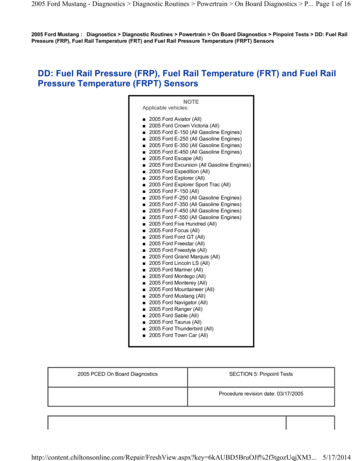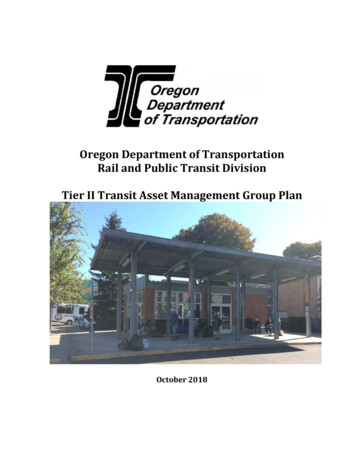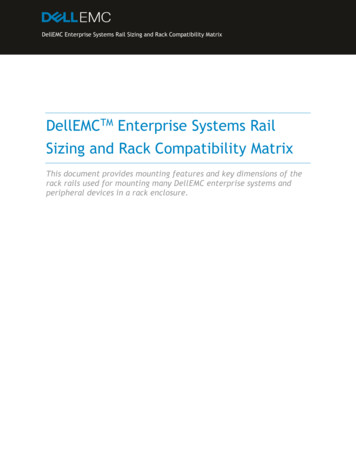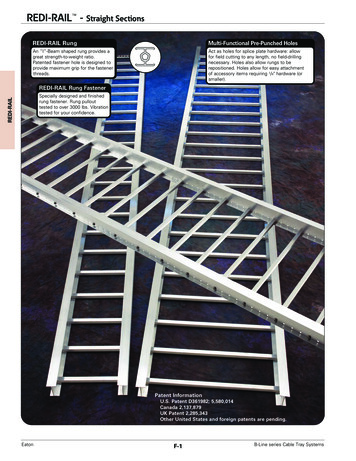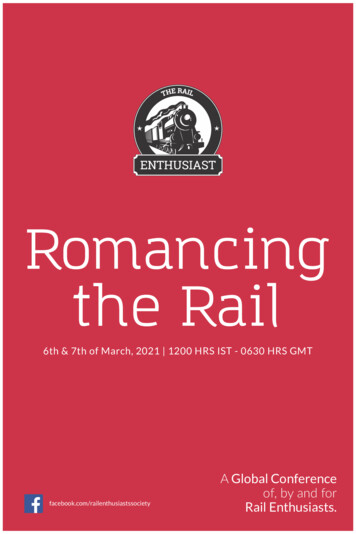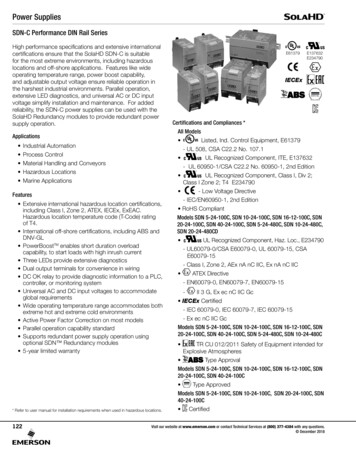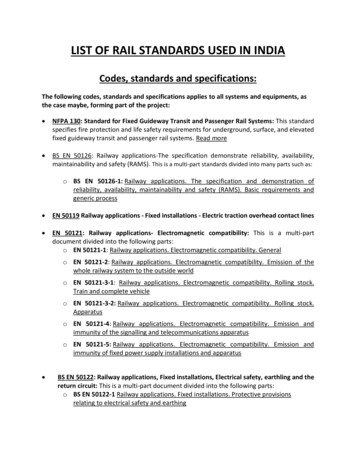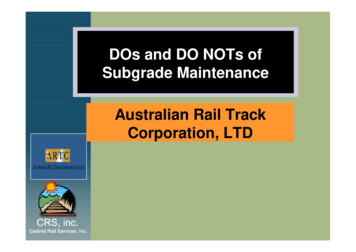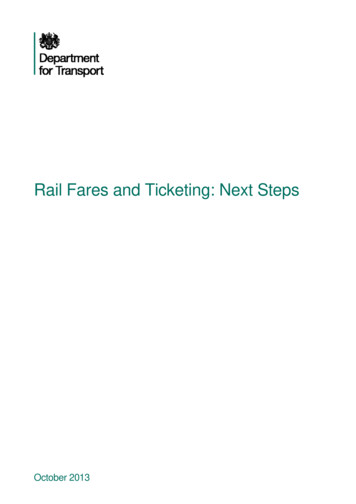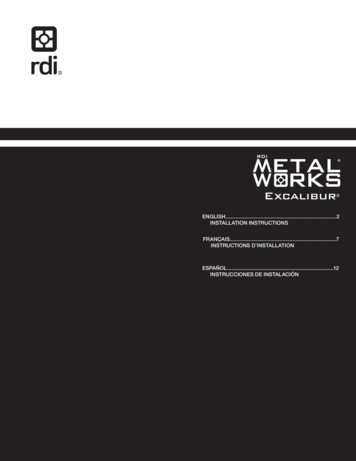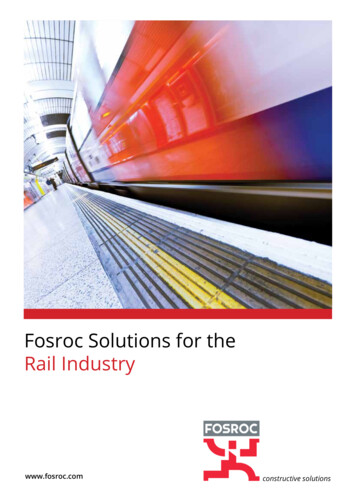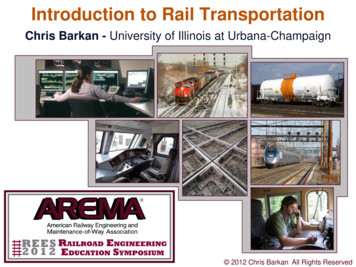
Transcription
Introduction to Rail TransportationChris Barkan - University of Illinois at Urbana-Champaign 2012 Chris Barkan All Rights Reserved 20122012ChrisAlltoRightsReservedREESModule#1 Barkan- IntroductionRail Transportation1
US rail freight traffic:1920-2010How many think rail transport isobsolete in the US? 2012 Chris Barkan All Rights ReservedREES 2012 Module #1 - Introduction to Rail Transportation2
Rail is the principal means of economicallymoving large, heavy freight long distances overland 2012 Chris Barkan All Rights ReservedREES 2012 Module #1 - Introduction to Rail Transportation3
Rail uniquely combines speed andenergy efficiency 2012 Chris Barkan All Rights ReservedREES 2012 Module #1 - Introduction to Rail Transportation4
Q: Where is the best railtransportation system in the world?A: It depends!Passengeror freight?Passenger: Probably Japan orone of the European countriesFreight: U.S. (and Canada)are virtually undisputed leaders 2012 Chris Barkan All Rights ReservedREES 2012 Module #1 - Introduction to Rail Transportation5
North American freight transportationvolume by modeBillions of TruckruckPPipelineipeline WaterwaysWaterwaysAAirirSource: AAR from Eno Foundation for Transportation 2012 Chris Barkan All Rights ReservedREES 2012 Module #1 - Introduction to Rail Transportation6
So who cares about freight transportation?Everyone should! 2012 Chris Barkan All Rights ReservedREES 2012 Module #1 - Introduction to Rail Transportation7
Why is railroad freight transport so important now,and even more so in the future? Lets consider the alternatives for inland transport truck, water, air, pipeline, conveyor belt 2012 Chris Barkan All Rights ReservedREES 2012 Module #1 - Introduction to Rail Transportation8
Truck Pros and Cons Pros: Speed, reliability, network coverage Cons: Energy efficiency, safety, land use, pollution, cost, congestion(because of shared use of infrastructure truck transport affects auto safetyand congestion as well)How many truckloadscan a railcar carry? 2012 Chris Barkan All Rights ReservedREES 2012 Module #1 - Introduction to Rail Transportation9
US Truck Freight Flows Highway network is comprehensive but increasinglycongested at many key nodes 2012 Chris Barkan All Rights ReservedREES 2012 Module #1 - Introduction to Rail Transportation10
Truck Congestion 2012 Chris Barkan All Rights ReservedREES 2012 Module #1 - Introduction to Rail Transportation11
Waterways Pros and Cons Pros: Energy efficiency, low cost, low pollution, safety, capacity Cons: Speed, limited networkNavigable Inland Waterways 2012 Chris Barkan All Rights ReservedREES 2012 Module #1 - Introduction to Rail Transportation12
US Waterway Freight Flows 2012 Chris Barkan All Rights ReservedREES 2012 Module #1 - Introduction to Rail Transportation13
Pipelines and Conveyor Belts Pros: High volume, continuous transport possible, no vehiclesneeded, low labor requirements Cons: Highly constrained types of commodities, limited productflexibility, speed and network 2012 Chris Barkan All Rights ReservedREES 2012 Module #1 - Introduction to Rail Transportation14
Major (Class 1) Railroads and over 500 short line & regional railroads 2012 Chris Barkan All Rights ReservedREES 2012 Module #1 - Introduction to Rail Transportation15
Seven large (Class 1)freight railroads– CSX & NS ineastern US– BNSF & UPin west– CN & CPin Canada ¢ral USNorth AmericanRailroad Network– KCS is a medium-sizedrailroad in central US 500 Short-lineand Regional railroads Amtrak operatespassenger trainsthroughout the USOutside the NortheastCorridor these are primarilyon freight railroad trackage Commuter rail operations in many large cities 2012 Chris Barkan All Rights ReservedREES 2012 Module #1 - Introduction to Rail Transportation16
U.S. Railroad Network ShowingFreight Traffic VolumeNote the importance of the “gateways”Chicago, St. Louis, Kansas City,Memphis, New OrleansGateways are where large amounts offreight are interchanged betweenwestern and eastern railroads 2012 Chris Barkan All Rights ReservedREES 2012 Module #1 - Introduction to Rail Transportation17
Elements of Railway Engineering 2012 Chris Barkan All Rights ReservedREES 2012 Module #1 - Introduction to Rail Transportation18
Typical modern freight equipment Modern freight locomotive (GE DashC44CW)4,400 horsepower,392,000 lbs 196 tons Typical freight carsFreight cars of two capacities are most common today:263,000 lbs GRL 131.5 tons“100 ton” or 263K286,000 lbs GRL 143.0 tons“110-ton” or 286KEmpty: ca. 60,000 lbs 30 tons each (but varies with size of car) 2012 Chris Barkan All Rights ReservedREES 2012 Module #1 - Introduction to Rail Transportation19
Basics of freight railcar weight and capacity The nominal capacity of a typical, 4-axle railcar today is 110 tons(formerly was 100 ton) Maximum Gross Rail Load (GRL) of a 110 ton, 4-axle railcaris 286,000 lbs. (weight of car contents or “lading”) Nominal capacity 220,000 lbs. or 110 tons of lading Often referred to as a “110 ton” car or a “286K” carLoad or Lading66,000 lbs. 220,000 lbs.Nominal CapacityApprox. 220,000 lbs 110 tonsLight weight or “tare” approx. 66,000 lbs 33 tonsCarbodyTrucks or "bogies" 2012 Chris Barkan All Rights Reserved286,000 lbs.Gross Rail Load (GRL)(actual light weight will varysomewhat depending on car size,consequently the weight-carryingcapacity will vary inversely,i.e lighter car larger capacity)REES 2012 Module #1 - Introduction to Rail Transportation20
Distribution of freight car capacity(freight cars in service 2011)MaximumGRLNominalCapacityNumber ofCars in ServicePercentageof Total220,000 lbs.70 ton178,96111.9%263,000 lbs.100 ton595,68039.2%286,000† lbs.110 ton700,89646.2%315,000 lbs.125 ton1,6530.1%All Other*41,4592.73%TOTAL1,474,800† Includes 64,284 cars with maximum GRL 268,000 lbs.(2011 UMLER data)* Primarily cars of higher capacity with more than 4-axles 2012 Chris Barkan All Rights ReservedREES 2012 Module #1 - Introduction to Rail Transportation21
Freight train size and tonnage Typical freight train is about 100 cars (generally range from 50 to 150 cars)cars x tons lading per car Railcar Gross Rail Load cars x tons of ladinglbs. GRL ( lbs. lbs tons)gross tonsPlus the weight of two locomotives, about 300,000 lbs each ons43 Tons143 Tonstons each x 2 tons of locomotivestons in consist 143 Tons143 Tons143 Tons 2012 Chris Barkan All Rights Reservedgross tons per train143 Tons143 Tons143 Tons150 Tons143 Tons143 Tons150 Tons143 Tons1143 TonsREES 2012 Module #1 - Introduction to Rail Transportation22
Freight train size and tonnage Typical freight train is about 100 cars (generally range from 50 to 150 cars)100 cars x 110 tons lading per car 11,000 tons of lading Railcar Gross Rail Load 286,000 lbs. GRL ( 143 tons)100 cars x 286,000 lbs. 28,600,000 lbs 14,300 gross tons Plus the weight of two locomotives, about 300,000 lbs each 150 tons each x 2 300 tons of locomotives 14,300 tons in consist 14,600 gross tons per trainons43 Tons143 Tons143 Tons143 Tons143 Tons 2012 Chris Barkan All Rights Reserved143 Tons143 Tons143 Tons150 Tons143 Tons143 Tons150 Tons143 Tons14143 TonsREES 2012 Module #1 - Introduction to Rail Transportation23
Intercity ton-miles is a common metric formeasuring freight traffic 1 ton-mile ton of freight movedmileTypical railcar weighs abouttons and can transport abouttons of ladingSo how many ton-miles does one fully loaded freight car generatewhen it moves one mile?revenue ton-miles weight of lading x milesgross ton miles (weight of lading railcar) x milesHow many does an empty car generate?revenue ton-milesgross ton miles One train per day for a year (including two locomotives) days tons million gross tons (MGT) One train moving 100 miles equals gross ton-miles (GTM) 2012 Chris Barkan All Rights Reservedtons xtons xmilesREES 2012 Module #1 - Introduction to Rail Transportation24
Intercity ton-miles is a common metric formeasuring freight traffic 1 ton-mile 1 ton of freight moved 1 mileTypical railcar weighs about 33 tons and can transport about110 tons of ladingSo how many ton-miles does one fully loaded freight car generatewhen it moves one mile?110 revenue ton-miles weight of lading x miles143 gross ton miles (weight of lading railcar) x milesHow many does an empty car generate?0 revenue ton-miles33 gross ton miles One train per day for a year (including two locomotives) 14,600 tons x365 days 5,329,000 tons 5.329 million gross tons (MGT) One train moving 100 miles equals 14,600 tons x 100 miles 1,460,000 gross ton-miles (GTM) 2012 Chris Barkan All Rights ReservedREES 2012 Module #1 - Introduction to Rail Transportation25
FlatcarTypes of freight carsBoxcarGondolaTank CarHopperAuto Rack CarCovered Hopper 2012 Chris Barkan All Rights ReservedREES 2012 Module #1 - Introduction to Rail Transportation26
Distribution of FreightCar Types 1.3 million freight cars operating in NorthAmericaRailroads own about 60% of the fleet,but Class 1 railroads own about 30%Covered hoppers most common type,– used for grain, plastic pellets, andsome chemicalsTank cars second most common,– used for liquid products– about half of these are for hazardousmaterialsHow much are these cars worth?– avg. 98,000 each to replace– 1.3 million x 98,000 127 BILLION!– Imperative that these assets bewell utilized 2012 Chris Barkan All Rights ReservedU.S. Freight Car OwnershipREES 2012 Module #1 - Introduction to Rail Transportation27
Railroad Traffic Mix: 2011 Tons OriginatedCoal is was King!– In terms of tons originated, it isthe leading commoditytransported by rail, followed bychemicals, farm products & nonmetallic minerals Notice that revenue is not directlycorrelated with tons originated .Why not?– Different commodities tend tobe shipped different distances(longer distance more revenue)– Different commoditiescommand different rates(more valuable commoditiescan bear higher shipping rates,but tend to require betterservice too) What are “Misc mixed shipments”? 2012 Chris Barkan All Rights ReservedREES 2012 Module #1 - Introduction to Rail Transportation28
Intermodal revenues exceeded coal forthe first time in 2004Intermodal* - 8.8Coal - 8.4Chemicals - 5.1Motor vehicles & parts - 3.7Farm products (mainly grain) - 3.2Food - 2.9Lumber & wood - 1.9Pulp & paper - 1.7Primary metal products (e.g., steel) - 1.5Stone, clay & glass products (e.g., cement) - 1.3Nonmetallic minerals (e.g., sand, gravel) - 1.10% 5%10%15%20%25%30%(From AAR)Amounts shown in billionsSince 2004, intermodal revenue slipped back into 2nd place, but the long-termtrend is clear - intermodal will dominate 2012 Chris Barkan All Rights ReservedREES 2012 Module #1 - Introduction to Rail Transportation29
Intermodal Definition Intermodal shipment: a freight shipment thatmoves between origin and destination usingtwo or more modes of transportation Two types of intermodalism:– Bulk– Unitized Growth of unitized intermodal shipmentshas been a spectacular trend intransportation Domestic and internationally standardizeddesigns for containers 2012 Chris Barkan All Rights ReservedREES 2012 Module #1 - Introduction to Rail Transportation30
Intermodal freightTrailersContainersIntermodal Transportation by more than one means of conveyance, as bytruck, ship and/or rail 2012 Chris Barkan All Rights ReservedREES 2012 Module #1 - Introduction to Rail Transportation31
Basic types of unitizedintermodal equipment &service Railroad intermodal transportationis typically described as either:– Trailer on flatcar (TOFC)– Container on flatcar (COFC) Although the early railcars used totransport these were flatcars,intermodal rolling stock hasbecome highly specialized “RoadRailer”, is a system in which a container can ride directly on either ahighway or railroad wheel assembly, without any railcar required 2012 Chris Barkan All Rights ReservedREES 2012 Module #1 - Introduction to Rail Transportation32
Rail Shipments of Trailers & ContainersRail intermodal traffic: 1990 - 2010Total(82% increase)Containers(247% increase)Trailers(50% decrease)Year Intermodal growth has been entirely in containers since the mid-1990s Trailer on flatcar (TOFC) traffic peaked in 1994 and has generally declinedsince then 2012 Chris Barkan All Rights ReservedREES 2012 Module #1 - Introduction to Rail Transportation33
Rail movement of intermodal traffic in US Rail lines serve as a “land bridge” for Pacific rim goods destined for theeast coast and Europe All of the west coast ports are important, but the dual ports of Los Angelesand Long Beach (San Pedro Bay) in Southern California are by far thedominant 2012 Chris Barkan All Rights ReservedREES 2012 Module #1 - Introduction to Rail Transportation34
Alameda Corridor connecting Ports of Los Angelesand Long Beach with U.S. railroad networkOpened April 2002 - on timeREESandon budget2012 Module #1 - Introduction to Rail Transportation 35 2012 Chris Barkan All Rights Reserved
U.S. Rail Network Depends on Chicago 25 percent of all U.S. rail traffic “touches” Chicago 46 percent of all intermodal units in the U.S. touch Chicago 54 percent of intermodal units to/from the ports of Seattle/Tacoma touch Chicago 26 percent of intermodal unitsto/from Los Angeles/Long Beachtouch Chicago Freight rail trade with Chicagois expected to increase 89%by 2035* Passenger, freight and motoristdelays are experienceddaily on the current system The region must improvefreight movement andmitigate negative impacts 2012 Chris Barkan All Rights ReservedREES 2012 Module #1 - Introduction to Rail Transportation36
Chicago terminal network needs extensiveinfrastructure work to accommodategrowing freight and passenger demand Current infrastructureinsufficient to handleexis
is 286,000 lbs. (weight of car contents or “lading”) Nominal capacity 220,000 lbs. or 110 tons of lading Often referred to as a “110 ton” car or a “286K” car 66,000 lbs. 220,000 lbs. 286,000 lbs. Gross Rail Load (GRL) (actual light weight will vary somewhat depending on car size, consequently the weight-carrying capacity will vary inversely, i.e lighter car larger .
